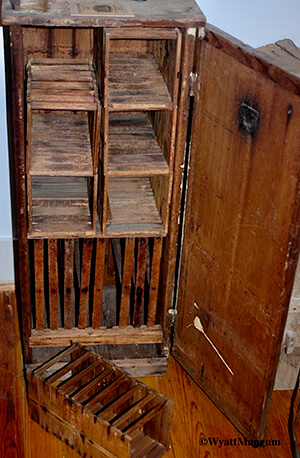
In the previous article, we learned how J.S. Harbison moved bees by steamship from Pennsylvania to California, a journey of 5,900 miles, taking the long route through Panama. In two shipments, occurring in 1857 and 1858, Harbison managed to get roughly 100 viable colonies to the West Coast. Some colonies were sold, and others were split. Early on he had 422 hives. At first, Harbison sold hives for an average of $100 each,1 an astounding price for those times. Well, perhaps for the East Coast. That colony price should be appreciated in the context of those historical times, particularly for the West Coast.
The California gold rush had begun in 1849. Instead of mining gold directly, which entailed long days of dangerous and debilitating work most often leading to economic ruin, some savvy entrepreneurs shipped in and sold the tools for mining: picks, shovels, boots, etc. Mining the miners as it were. Furthermore, the great influx of people needed food supplies and livestock.
Harbison essentially took to California a very valuable livestock, and one that was small, making it relatively easy to ship. Moreover, bees have a fast developmental time. Rebuilding colony numbers after selling some would be fairly quick (a biological limitation with cattle or horses). And then there was the timing. Harbison arrived with bees right when the demand was excruciatingly high and the supply was extremely low.
Merchants depended on additional shipments of wares to further their livelihood (at least initially); Harbison could manage his bees to replace the colonies that were sold. In all, a clever, if temporary, business plan. As others moved bees to California, supplying the demand, Harbison turned his attention from colony sales to honey production in the vast undisturbed range of flowers that was once California.
Also recall that when Harbison was back home in Pennsylvania, planning the first large bee shipments to California, he saw a Langstroth hive, a pivotal event in his apicultural experience. The advantages of the removable frame based on the bee space impressed him. It gave the beekeepers complete control over the combs, a feature sorely lacking in his fixed-comb chamber hives, which we saw in the previous article. Even though the Langstroth frame needed some modifications, Harbison resolved to develop his style of frame hive. Eventually he would transfer his beekeeping operation from fixed combs to frames, a laborious and costly endeavor.
In their full glory almost 4,000 California hives, as they were once known, flourished in the west, forming a unique beekeeping operation.1 Figure 1 shows a California hive, definitely not a typical-looking hive by today’s standards. It looks more like a free-standing cabinet, opening from the rear. This access kept the beekeeper away from the entrances and out of the bee flight on the other side (see Figure 2). The hive could not be enlarged by adding supers; in fact, the top was nailed on. Early on, when Harbison conceived of the California hive, supers, as we know them today, did not exist (see Figure 3).
Given its unusual design, let’s try to understand why Harbison made the hive in this manner. His former hive, a chamber hive, most likely influenced the design of his California frame hive. In addition to the chamber hive shown in the previous article was another common version, one with a rear-opening door similar to a California hive (see Figure 4). Inside this chamber hive, the general layout is even reminiscent of a California hive. In the chamber hive is a horizontal partition, a fixture we saw last time in this kind of hive. Under the partition is the fixed-comb brood nest, a throwback to the old primitive box hive era. Enlarge that volume, fit it with Langstroth frames, and it leaps forward to more contemporary beekeeping, a California hive brood nest. (The horizontal partition in the chamber hive was sometimes called a “honey board” in later hives, and it can be seen as the remote ancestor of the modern queen excluder.)
Now let’s remove a brood frame and see how Harbison designed his frames (see Figure 5). Here’s where beekeeping mindsets from two different centuries crash head-on. His frame is 13 inches in depth and about 12 inches wide, a deep and narrow frame. What we would call the bottom bar is positioned about midway up the frame. Furthermore, the top bar has a square cross section and is turned so that one of the edges (a corner) points downward, rather than being flat underneath like a typical rectangular top bar. It seems like Harbison attached the top bar incorrectly.
In figuring out why a beekeeper built a hive in a certain way, perplexing as that can be, one cannot always look at just the hive itself. Understanding the hive design comes when one unravels the context. The context changes depending on ….


